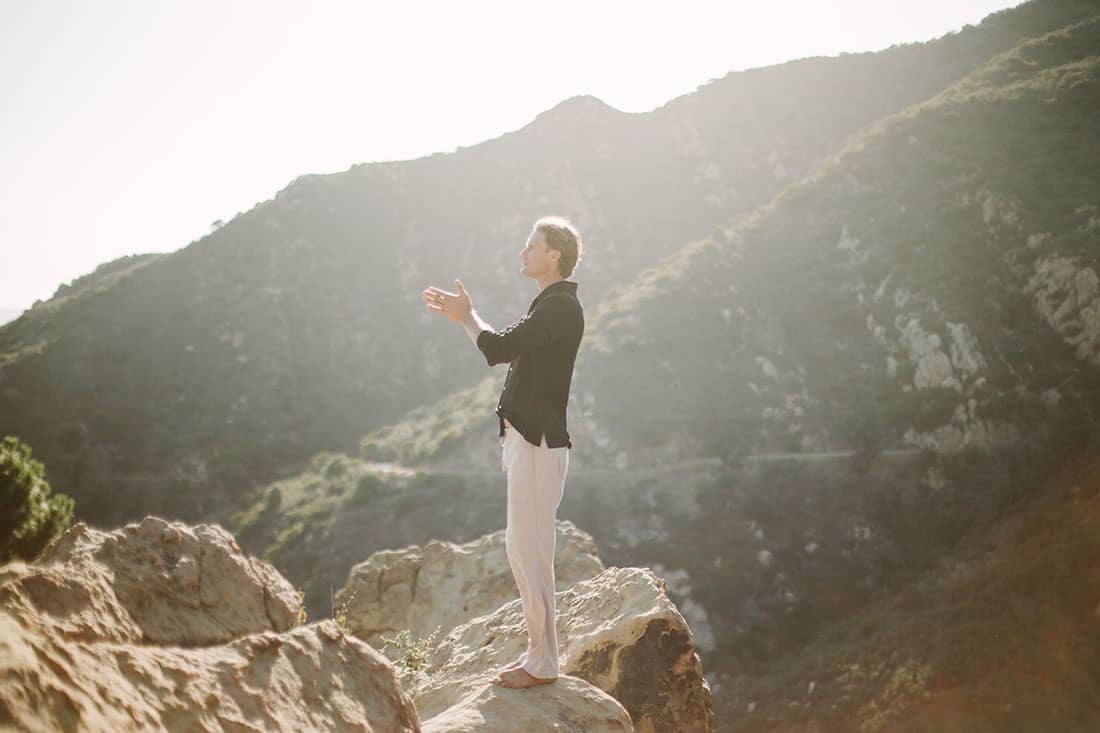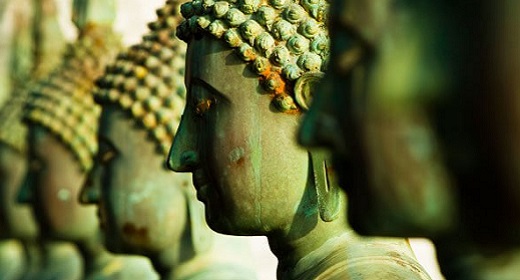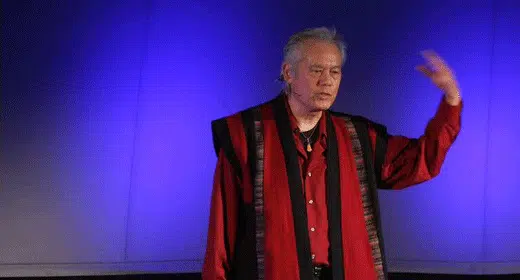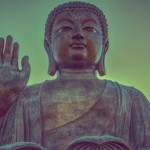by Misha Cohen: Qigong (pronounced: chee-gun), which combines meditative and physically active elements, is the basic exercise system within Chinese medicine…
 Qigong exercises are designed to help you preserve your Jing, strengthen and balance the flow of Qi energy, and enlighten your Shen.
Qigong exercises are designed to help you preserve your Jing, strengthen and balance the flow of Qi energy, and enlighten your Shen.
Its dynamic exercises and meditations have Yin and Yang aspects: The Yin is being it; the Yang is doing it. Yin qigong exercises are expressed through relaxed stretching, visualization, and breathing.
Yang qigong exercises are expressed in a more aerobic or dynamic way. They are particularly effective for supporting the immune system. In China, Qigong is used extensively for people with cancer.
Qigong’s physical and spiritual routines move Qi energy through the Twelve Primary Channels and Eight Extra Channels, balancing it, smoothing the flow, and strengthening it. Chinese medicine uses Qigong exercises to maintain health, prevent illness, and extend longevity because it is a powerful tool for maintaining and restoring harmony to the Organ Systems, Essential Substances, and Channels. Qigong is also used for non-medical purposes, such as for fighting and for pursuing enlightenment.
Anyone of any age or physical condition can do Qigong. You don’t have to be able to run a marathon or bench press a car to pursue healthfulness and enjoy the benefits.
When you design your qigong exercise / meditation practice, you will pick what suits your individual constitution. Some of us are born with one type of constitution; some with another. We each have inherited imbalances that we cannot control but with which we must work. That’s why for some people it is easier to achieve balance and strength than it is for others. But whatever your nature, Qigong can help you become the most balanced you can be.
Qigong is truly a system for a lifetime. That’s why so many people over age sixty in China practice Qigong and Tai Chi. The effects may be powerful, but the routines themselves are usually gentle. Even the dynamic exercises—some of which explode the Qi energy— use forcefulness in different ways than in the West. The following are some effects of Qigong exercises practiced regularly.
The Benefits of Regular Practice
Maintaining Health
Qigong exercises help maintain health by creating a state of mental and physical calmness, which indicates that the Qi energy is balanced and harmonious. This allows the mind/body/spirit to function most efficiently, with the least amount of stress.
When you start practicing Qigong exercises, the primary goal is to concentrate on letting go, letting go, letting go. That’s because most imbalance comes from holding on to too much for too long. Most of us are familiar with physical strength of muscles, and when we think about exercising, we think in terms of tensing muscles. Qi energy is different. Qi strength is revealed by a smooth, calm, concentrated effort that is free of stress and does not pit one part of the body against another.
 qigong exercises are often used to develop and strengthen the energy body in preparation for higher states and stages of consciousness. photo: lerina winter
qigong exercises are often used to develop and strengthen the energy body in preparation for higher states and stages of consciousness. photo: lerina winter
Managing Illness
It’s harder to remedy an illness than to prevent it, and Qigong has powerful preventive effects. However, when disharmony becomes apparent, Qigong exercises also can play a crucial role in restoring harmony.
Qigong movement and postures are shaped by the principle of Yin/Yang: the complementary interrelationship of qualities such as fast and slow, hard and soft, Excess or Deficiency, and External and Internal. Qigong exercises use these contrasting and complementary qualities to restore harmony to the Essential Substances, Organ Systems, and Channels.
Extending Longevity
In China, the use of Qigong exercises for maintaining health and curing illness did not satisfy those Buddhists and Daoists who engaged in more rigorous self-discipline. They wanted to be able to amplify the power of Qi energy and make the internal Organ Systems even stronger. This arcane use of Qigong was confined mostly to monasteries and the techniques have not been much publicized. One of the most difficult and profoundly effective techniques is called Marrow Washing Qigong. Practitioners learn to master the intricate manipulation of Qi—infusing the Eight Extraordinary Channels with Qi, and then guiding the Qi energy through the Channels to the bone marrow to cleanse and energize it. The result, according to religious tradition, is that monks can extend their life span to 150 years or more. The Daoists have a saying, “One hundred and twenty years means dying young.”
Although few if any of us can devote our lives to the stern practices of the monks, the health benefits of Qigong exercises certainly do improve the quality of life of everyone who practices it.
Around 500 CE, in the Liang Dynasty, Qigong was adopted by various martial artists to increase stamina and power. For the most part, the breathing, concentration, and agility were assets to the warriors and improved their well-being.Attaining Enlightenment
Buddhist monks who use Qigong exercises in their pursuit for higher consciousness and enlightenment concentrate on the Qigong’s ability to influence their Shen. Mastering Marrow Washing allows the practitioner to gain so much control over the flow of Qi energy that he or she can direct it into the forehead and elevate consciousness. The rest of us can enjoy the influence of Qigong on our Shen (spiritual body/energy), but at a lower level.Whatever reason you use Qigong, the practice should raise your Qi to a higher state if you increase concentration, practice controlled breathing, and execute the Qigong routines.
The Foundational Techniques
Here are the basic Qigong exercise techniques.
Concentration
Concentration leads to and results from Qi energy awareness, breathing techniques, and Qigong exercises. It is a process of focusing in and letting go at the same time. Focusing does not mean that you wrinkle up your forehead and strain to pay attention.
Instead, through deep relaxation and expanding your consciousness, you are able to create a frame of mind that is large enough to encompass your entire mind – body – spirit’s functions, yet focused enough to allow outside distractions, worries, and everyday hassles to drift away.
This inward focus that expands outward to join you with the rhythms of the universe epitomizes Yin/Yang. Yin energy tends to be more expansive, and Yang energy more concentrated. You discover your Yin/Yang balance by treating Yin and Yang as ingredients in a recipe: Add a bit more Yin, toss in a dash of Yang to make the mixture suit your constitution or circumstances.
Some people need more or less Yin or Yang, depending upon the situation. ‘Extending the Qi exercise’ outlined below provides a clear demonstration of how you can practice establishing your balanced blend of Yin and Yang.
You will find that as you do qigong exercise and meditation you become more adept at this form of concentration, because it is the natural expression of the practice. As you learn to concentrate more effectively, you will find you have greater power to affect Qi energy through the various Qigong exercises in this chapter or through the use of other focused meditations and Tai Chi.
Breathing
In the sixth century BCE, Lao Tzu first described breathing techniques as a way to stimulate Qi energy. From there, two types of Qigong breathing exercises evolved: Buddha’s Breath and Daoist’s Breath. Both methods infuse the body with Qi and help focus meditation.
Buddha’s Breath: When you inhale, extend your abdomen, filling it with air. When you exhale, contract you abdomen, expelling the air from the bottom of your lungs first and then pushing it up and out until your abdomen and chest are deflated. You may want to practice inhaling for a slow count of eight and exhaling for a count of sixteen. As you breathe in and out, imagine inviting your Qi energy to flow through the Channels. Use your mind to invite the Qi to flow; you want to guide the flow, not tug at it or push it.
Daoist’s Breath: The pattern is the opposite of above. When you breathe in, you contract your abdominal muscles. When you exhale, you relax the torso and lungs.
As you travel through these steps, remember that Qigong is a process of building awareness. However you are comfortable doing the routines is what’s right for you at that time.
Warm-Up Exercises (10 to 15 min.)
Qigong Exercise One: Gentle Sway
1. For five minutes, move both of your arms from your shoulders in a gentle swinging motion. The motion itself is initiated from your waist: Twist from the waist as though your torso were a washcloth that you were wringing out. Don’t twist from the knees or you may harm them. Furthermore, twisting from the waist provides a massage to the internal organs and provides you the full benefits of the exercise.
2. To get started, move your arms side to side across your torso, and then back to front.
3. Keep your knees slightly bent. Let your hips sway. Allow your mind to clear. At first, focus on the release of unnecessary and unconscious stress. After several weeks, you may shift your focus so that you think only about the swaying of your arms and the motion of Qi energy.
This introduces you to the concept of being mindful of the present, much the same concept as found in Zen walking.
Qigong Exercise Two: The Bounce
In the beginning, try this for one to three minutes.
1. With your feet parallel and about shoulder’s width apart, bounce with your knees loose and your arms hanging at the sides like a wet noodle. They should feel empty and neutral. This is the zero position for your arms. When you are bouncing back and forth, your arms in zero should get a nice jiggling effect.
2. Keep your shoulders natural; neither pull them back or let them slump forward too much. When the zero position is used on the whole body, you should receive a feeling of deep relaxation and your internal organs and skin should hang down. This process brings awareness of internal tension so that you can do something to dispel it, if you choose.
The combination of exercises one and two gently massages and tonifies the Organ Systems, which helps promote longevity.
Ready to Go Deeper? Free Qi Gong Course: Activate Your Body’s Energetic Healing Abilities
Master Qi Gong teacher and energy healing expert Lee Holden will be sharing some of his deepest practices, insights and teachings on how to use Qi Gong to activate your body’s natural healing abilities, accelerate your spiritual growth, expand your consciousness and significantly improve your health and wellness.
Awareness Exercises
Qigong Exercise Three: Accordion
In this, you feel the Qi energy by using your hands like the bellow of an accordion or a bicycle pump.
1. Close your eyes halfway. Clear your mind and concentrate your attention on your palms.
2. Allow your breath to become slow, easy, without force. In a way, you are creating the very lightest trance.
3. Bring your hands together, palms touching and fingers pointing upward. The palm chakras, called Laogong, located in the center of the palms, should be touching. These chakras are areas where Qi can be felt emanating from the body.
4. Slowly move your hands, keeping the chakras aligned. When they are about 12 inches (30 cm) apart, slowly move them together using the least amount of physical effort possible.
5. You will be compressing the air between them like an accordion would.
6. Feel a warm or tingling sensation at the Laogong points on your palms.
7. Move your hands slowly back and forth, varying the range of the bellows. Repeat the accordion technique in different directions: horizontally, vertically, and diagonally.
This exercise cultivates Qi, builds awareness, and sensitizes yourself. When you feel Qi energy for the first time, it changes your mind-set.
Qigong Exercise Four: Making the Point
1. Using your index finger is a powerful way of directing Qi energy. If you are right-handed, use you right index finger; if you are left-handed, use your left index finger. Point it directly at the flat palm of your other hand. That hand should be perpendicular to the floor with your fingers pointing straight up.
2. Use your index finger like a paintbrush to swab back and forth across your palm.
3. Begin with your fingertip about 8 inches (20 cm) from your palm. Slowly move it closer and farther away, swabbing all the time.
You may feel a tickling sensation, a cooling, or a warming of your palm.
Qigong Exercise Five: Extending the Qi
If you have Deficient Qi, you should perform this exercise with your eyes half closed to cultivate and accumulate Qi energy.
1. If you have Stagnant Qi, the exercise may be done with your eyes fully open. You will inhale swiftly through your nostrils with your eyes open or half closed when you exhale.
Note: You should exercise caution when practicing Qi exercises at home—without a teacher nearby—because they are powerful, and Qi can leak out your eyes.
2. Once you can sense the Qi, exercise your intention (which is the mind/spirit part of the exercise) and use your mind to move your Qi out from your body, expanding the zone in which you are comfortable. You may allow the Qi to drift out on the exhalation and then hold it there as you inhale.
3. First move the Qi into an orbit 1 inch (2.5 cm) from your skin. In increments of 6 inches (15 cm), move it outward, aiming for 3 feet (91 cm), but find the point where you are comfortable with it. Then bring it back in until it returns close to your body.
This qigong exercise allows you to communicate with your Qi energy. By increasing the distance away from your body that you can feel Qi, you expand your area of comfort—your field of generosity—in the world around you. You will have less fear and greater abilities. By being able to bring your Qi halo in to skin level (or inside your skin) you may become more centered, calm, and self-assured. When you have learned to be comfortable expanding and contracting your Qi, you will feel stronger, healthier, and more in harmony internally and externally.
Qigong Exercise Six: Pumping the Qi
This is a tricky exercise that moves the Qi energy along the two connecting Extraordinary Channels: the Du Mai and Ren Mai. You may think of it as evolve, devolve, because your posture goes from a slumped, gorilla-like stance to an upright extended pose. It is adapted from the Wild Goose Qigong exercise routine.
1. The first position pushes the Qi down. As your hands push flat down, your spine and head straighten upward. Then as you allow the Qi to flow back upward, your hands rise, elbows bent and palms parallel to the floor. Your shoulders hunch. Repeat this six or seven times, inhaling as your hands come up and exhaling as your hands go down.
2. When you are comfortable with this Qigong exercise, you may combine it with a slow intentional walk forward: left knee bent and raised in an exaggerated stepping motion. When your knee comes up, your hands go down and back and your spine straightens; when your foot touches the ground, your hands come up and your back hunches. Place your feet very gently on the ground and allow each step to proceed in slow motion, at a tempo that soothes and relaxes. Remember to maintain a breathing pattern, too. Inhale as your hands come up and your shoulders hunch. Exhale slowly, expanding your chest as you straighten your back. If this feels awkward, don’t despair. Even in a classroom situation, it takes a while to catch on to what to do.
Qigong Exercise Seven: Blending Qi
This exercise should help you become aware of various resonations of Qi energy and learn to blend them into a harmonious flow.
1. Stand with your feet a shoulder’s width apart, with your knees slightly bent. Allow your hands and arms to hang at your sides.
2. Shift your weight slightly to the balls of your feet. Simply be aware of the front side of your body. Concentrate on the Channels that pass along the front of your legs and torso, the top of your hands and arms, and your face.
3. After one minute, shift your weight to your heels. Become aware of the back of your body: the back of your head, your arms, your spine, and your legs. With practice, you may hold these postures for up to five minutes or longer.
4. You can also do this for the left and right sides of the body.
5. In each instance, you may want to become aware of each section of the body. For example, the side of your head, the side of your arm and torso, your outer hip, the side of your leg and ankle, and the length of your foot. This makes the exercise a meditation.
6. Now, shifting to a more Nei Dan form of Qigong exercise, repeat the first three steps, but the motion should not be detectable visually. Use your mind to shift your weight forward and backward, feeling your Qi flowing along the front and back of your body.
7. Next, try to feel your Qi flowing along your back and front simultaneously.
Students are often bewildered by the idea of feeling two sensations at the same time, but a useful analogy is to think of the color yellow and the color blue. When you blend those two colors together, you produce green. That green then becomes its own entity with its own wavelength. The same is true of blending the Qi energy from your front and from your back. The blend becomes another entity with its own resonation.
Advanced Qigong Breathing Exercise
Breathing can direct Qi energy through the body like the wind filling the sails of a ship. Qigong breathing exercises can invigorate or sedate, depending on how you use them.
On alternate days, practice the following routine, using Buddha’s Breath and Daoist’s Breath breathing techniques.
1. Sit on the floor with your legs crossed in lotus or cross-legged style. This is important so that Qi energy does not enter and become Stagnant in the lower body, but follows the breathing path through your torso and your head.
2. Inhale to a count of four to eight, depending on what you are comfortable with. For Buddha’s Breath, extend your belly, filling it up from the bottom. For Taoist’s Breath, inhale, contracting your abdomen, and exhale, letting your abdomen relax outward.
3. As you inhale, turn your attention to your nose. Guide the Qi energy downward from your nose toward the Dantian, 1 to 2 inches (2.5 to 5 cm) below the navel. Women should not concentrate on the Dantian during their periods. Concentrate on your solar plexus instead.
4. Exhale to a count of eight to sixteen and move the Qi energy down the torso, around your pelvic region, and up to your tailbone.
5. Inhale and move the Qi up the back to the top of your shoulders.
6. Exhale and move the Qi up the back of your head and back to your nose.
7. If you cannot feel the Qi clearly, patience and practice will make it more apparent.
8. Once you are comfortable with this Qigong practice, you may increase the pace by completing the cycle in one inhalation and one exhalation. On the inhalation, move Qi energy from your nose to your tailbone. On the exhalation, move Qi from your tailbone back to your nose.








































